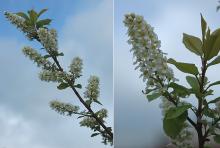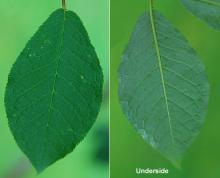Prunus padus
Common name:
European Birdcherry
Common Birdcherry
Pronunciation:
PROO-nus PA-dus
Family:
Rosaceae
Genus:
Type:
Broadleaf
Native to (or naturalized in) Oregon:
No
- Deciduous tree, to 30-40(50) ft (9-12 (15) m) tall, ascending branches, rounded shape. Bark rough, gray to dark brown. Leaves alternate, simple, obovate to elliptic, 6-13 cm long, 3.5-6 cm wide, base wedge-shaped, margin with fine sharp teeth, tip abruptly pointed, dull green above, grayish and hairless below, petiole 1-1.5 cm long, usually with two glands; fall color yellow to bronze. Flowers white, 1-1.5 cm wide, fragrant, petals 6-8 mm long, twice as long as stamens, calyx-tube pubescent inside, in loose upright to drooping clusters (racemes) 10-15 cm long. Fruit globose, 6-8 mm, glossy black; stone oval, rugose (wrinkled); fruit relished by birds but too bitter for humans.
- Sun to shade. Prone to aphids and a disfiguring black knot disease.
- Hardy to USDA Zone 3 Native to Europe, northern Asia, to Korea and Japan. Long cultivated and several cultivars are available.
- padus: Greek, pados, a tree
- Oregon State Univ. campus: southeast Dixon Rec., near service road.
Click image to enlarge
















